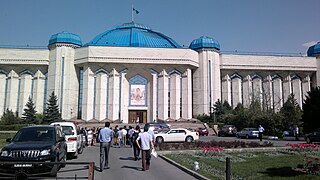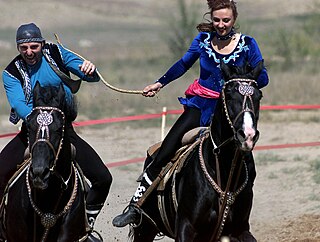 W
WKazakhstan has a well-articulated culture based on the nomadic pastoral economy of the inhabitants. Islam was introduced to Kazakhstan in the 7th to 12th centuries. Besides lamb, many other traditional foods retain symbolic value in Kazakh culture. Kazakh culture is largely influenced by the Turkic nomadic lifestyle. Kazakh culture seems also to be strongly influenced by the nomadic Scythians.
 W
WAqsaqal or aksakal metaphorically refers to the male elders, the old and wise of the community in parts of Central Asia, the Caucasus and Bashkortostan. Traditionally, an aqsaqal was the leader of a village or aul until the Soviet times. Acting as advisors or judges, these elders have or had a role in politics and the justice system in countries and tribes. For instance, there are aksakals courts in Kyrgyzstan. In Uzbekistan, which has traditionally been a more urban society, cities are divided up into mahallas. Each mahalla has an aqsaqal who acts as the district leader.
 W
WAkyns, or aqyns, are improvising poets and singers in the Kazakh and Kyrgyz cultures. Akyns differ from the zhirau or manaschi, who are song performers or epic storytellers.
 W
WThe Day of the Capital City of Kazakhstan is an official public holiday in Kazakhstan. It was established in 2009 and is celebrated on July 6 to celebrate the capital city of Kazakhstan, Nur-Sultan. The holiday also coincides with the birthday of ex-President Nursultan Nazarbayev.
 W
WThe Central State Museum of Kazakhstan is the largest museum in Almaty, Kazakhstan, and one of the largest museums in Central Asia.
 W
WChapan (چاپان) or (چپان) is a coat worn over clothes, usually during the cold winter months. Usually worn by men, these coats are adorned with intricate threading and come in a variety of colors and patterns. It is worn in Central Asia, including Uzbekistan, Afghanistan, Tajikistan, Kazakhstan and Kyrgyzstan. A chapan cape was often worn by former Afghan president Hamid Karzai.
 W
WA Dauylpaz is a percussion signal instrument used by the Kazakhs. The drum-like instrument was originally used to convey signals during battle, and later became commonplace in Kazakh culture. The instrument fell out of widespread use in the 20th century.
 W
WDombyra Party — is a flash mob-like movement of Kazakh youth to popularize Kazakh national musical instruments, especially dombyra. The movement is non-political.
 W
WHunting with eagles is a traditional form of falconry found throughout the Eurasian Steppe, practised by ancient Khitan and Turkic peoples. Today it is practised by Kazakhs and the Kyrgyz in contemporary Kazakhstan and Kyrgyzstan, as well as diasporas in Bayan-Ölgii Provinces Bayan-Ölgii, Mongolia, and Xinjiang, China. Though these people are most famous for hunting with golden eagles, they have been known to train northern goshawks, peregrine falcons, saker falcons, and more.
 W
WKazakh clothing, worn by the Kazakh people, is often made of materials suited to the region's extreme climate and the people's nomadic lifestyle. It is commonly decorated with elaborate ornaments made from bird beaks, animal horns, hooves and feet. Although contemporary Kazakhs usually wear Western dress, the Turkic people wear more traditional clothing for holidays and special occasions.
 W
WKimeshek or Elechek is a traditional headgear of married women with children in Kazakhstan, Karakalpakstan and Kyrgyzstan. Kimeshek is also worn by Central Asian Jewish women. Uzbek and Tajik women wear a similar headdress called lachak. Kimeshek is made of white cloth, and the edge is full of patterns. Kimeshek might have different designs and colors based on the wearer's social status, age, and family.
 W
WKyz-Zhibek is a Kazakh poetic folk legend of the 16th century, tells about the period in the Kazakh nation when the people suffered from bloody feuds. In those times each province of the Kazakh nation had its own Khan and each tried to supersede the other. The love story of Tölegen, the brave warrior, and the beauty Jıbek ends tragically because of inter-family strife. Tölegen is foully murdered by Bekejan, who earlier strived for the hand of Jıbek. Jıbek commits suicide after learning about the death of Tölegen.
 W
WThe State Anthem of the Republic of Kazakhstan is the national anthem of Kazakhstan, adopted on 7 January 2006.
 W
WA shyrdak or syrmak is a stitched, and often colourful felt floor-covering, usually handmade in Central Asia. Kazakhs and Kyrgyz alike traditionally make shyrdaks, but especially in Kyrgyzstan, the tradition is still alive, and many of the products are sold to tourists.
 W
WSuzani is a type of embroidered and decorative tribal textile made in Tajikistan, Uzbekistan, Kazakhstan and other Central Asian countries. Suzani is from the Persian سوزن Suzan which means needle. The art of making such textiles in Iran is called سوزندوزی Suzandozi (needlework). Suzanis amazingly not disappear in the late 18th and early 19th centuries. In the early 15th century, Ruy Gonzáles de Clavijo, the Castilian ambassador to the court of Timur (Tamerlane), left detailed descriptions of embroideries that were probably forerunners of the suzani.
 W
WA tubeteika is a Russian word for many varieties of traditional Central Asian caps. Tubeteikas are today worn in Tajikistan, Kazakhstan, Kyrgyzstan, and Uzbekistan, as well as in Muslim-populated regions of Russia and Azerbaijan. The skullcap worn by Uzbeks and Uyghurs is called a doppa and has a square base. It was a popular headgear among children throughout the USSR during the 1940s and 1950s.
 W
WTush kyiz are large, elaborately embroidered wall hangings, traditionally made in Kyrgyzstan and Kazakhstan by women to commemorate the marriage of a son or daughter. Colors and designs are chosen to symbolize Kyrgyz traditions and rural life. Flowers, plants, animals, stylized horns, national designs and emblems of Kyrgyz life are often found in these ornate and colorful embroideries. Designs are sometimes dated and signed by the artist upon completion of the work, which may take years to finish. The tush kyiz is hung in the yurt over the marriage bed of the couple, and symbolize their pride in their Kyrgyz tradition.
 W
WThe wedding in native Kazakh language is Uilenu toyi, the marriage is Ui bolu.